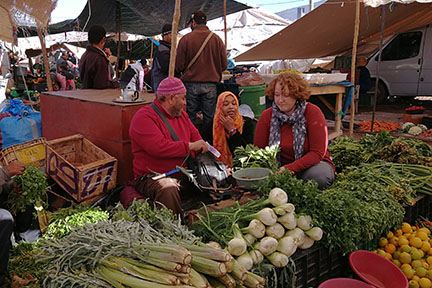IMAGE OF THE WEEK

Not all Penn State geographers went to the American Association of Geographers annual meeting in New Orleans. Alan Taylor shares this photo from the US Regional Association of the International Association for Landscape Ecology in Chicago. Pictured left to right: Alan Taylor, Lucas Harris, Jamie Peeler, and Natalie Pawlikowski, at the Cloud Gate sculpture, nicknamed, “the bean.”
GOOD NEWS
- Alumnus Joshua Stevens @jscarto was recognized as one of 50 Must-Follow Twitter Accounts for Geospatial, Data Science, and Visualization.
- Carolyn Fish accepted a tenure-track job as an Assistant Professor at the University of Oregon.
- Alumnus Peter Howe (’12g) was awarded an NSF CAREER grant from the Geography and Spatial Sciences program. The 5-year project is titled “CAREER: Location-Aware Social Science for Adaptation: Modeling Dynamic Patterns in Public Perceptions and Behavior.”
- Josh Inwood will deliver the inaugural Liberal Arts First-Year Valedictory Address.
- Aparna Parikh has accepted an offer for a Mellon Postdoctoral Fellowship by the Leslie Center for the Humanities at Dartmouth College, and will be housed in their Department of Geography.
- Cary Anderson won the AAG Cartography Speciality Group’s Illustrated Paper Award for her work on assessing emotional reactions to different map designs.
- Julie Sanchez received an award from the Pennsylvania Space Grant Consortium.
RECOGNITION RECEPTION
Department to hold annual Recognition Reception on Friday, April 27
Throughout the academic year, our faculty, students, staff, alumni, and friends have contributed significantly to our department, community, and society. To extend our appreciation, we will recognize the accomplishments of our community during this annual event. This year’s Recognition Reception will feature the department’s graduating seniors, which provides a special opportunity to join them in celebrating their experience in the department and embarking on the next phase of their lives.
- Reception and Master’s Poster Display: 3:00-3:30 p.m. and 4:30-5:00 p.m., 3rd floor, Walker Building
- Awards Ceremony: 3:30-4:30, 112 Walker Building
- Watch webcast on Mediasite
- Register to attend
NEWS
Fighting fire with societal norms
There are a few statistics about women firefighters that stand out to Penn State researcher Lorraine Dowler.
Women account for about 7 percent of firefighters nationwide. Men and women firefighters have the same average age, but women are paid $10,000 less, on average, according to U.S. Census Bureau data. Even in the San Francisco Fire Department, which has made great strides toward equal representation, just 15 percent of firefighters are women. In the Fire Department of the City of New York (FDNY), that figure is less than 1 percent.
Undergraduate Exhibition wraps up record year
Arts and Humanities winner is working with Alex Klippel and Jiawei Huang in ChoroPhronesis
Hundreds of students and judges bustled about in the HUB-Robeson Center Wednesday evening for the 2018 Undergraduate Research Exhibition on the University Park campus of Penn State. From musical presentations in the Flex Theater posters in Alumni and Heritage halls, the University’s best were promoting the fruits of their academic and artistic pursuits.
Students see green: Mock spill illustrates potential impact of wastewater leak
Bright green water swirled around Mariah Airey’s boots as it made its way into Black Moshannon Creek.
A freshman at State College Area High School, Airey watched as green dye trickled down a tributary, mixed with the clear water in the creek and then rushed downstream.
RECENTLY PUBLISHED
The future of behavioral and cognitive geography: a coda
Roger Downs
Handbook of Behavioral and Cognitive Geography, 2018
American archives and climate change: risks and adaptation
Mazurczyk, T., Piekielek, N., Tansey, E., & Goldman, B.
Climate Risk Management
https://doi.org/10.1016/j.crm.2018.03.005
Climate change directly affects the future security of cultural resources. Cultural heritage and in particular, archives, are increasingly at risk of degradation due to climate change threats and triggers. This study evaluated present and future consequences of water-related climate change impacts using a mapping methodology to assess exposure of American archives to incompatible weather extremes.
HIV as social and ecological experience
Brian King and Margaret S. Winchester
Social Science and Medicine
https://doi.org/10.1016/j.socscimed.2018.04.015
The spread and varied impacts of the HIV/AIDS epidemic demonstrate the complex and reciprocal relationships between the socio-political and biophysical dimensions of human health. Yet even with increasing research and policy attention there remain critical gaps in the literature on how HIV-positive households manage health through their engagement with social and ecological systems. This is particularly urgent given improvements in the global response to the epidemic, whereby expanded access to antiretroviral therapy has extended the possibility for survival for years or decades. Because many HIV-positive families and communities in the Global South remain dependent upon a diverse set of resources to generate income and meet subsistence needs, the impacts of disease must be understood within a mix of social processes, including the maintenance of land and collection of natural resources.

 Bronwen Powell (right) shared this photo from Asni Market in the High Atlas Mountains near Marrakech, Morocco in December 2017. She is interviewing a vendor and assisted by a translator.
Bronwen Powell (right) shared this photo from Asni Market in the High Atlas Mountains near Marrakech, Morocco in December 2017. She is interviewing a vendor and assisted by a translator.